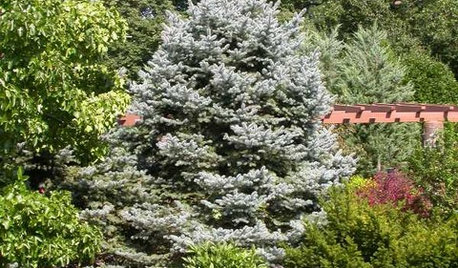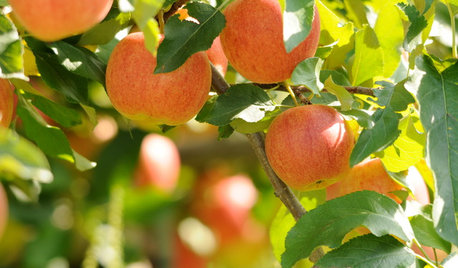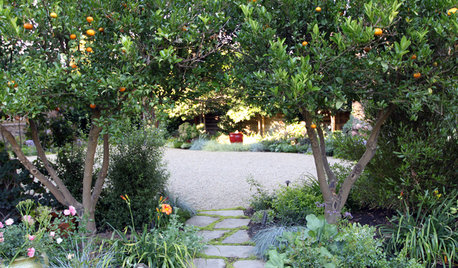Evergreen fruit tree?
Leana M
7 years ago
Featured Answer
Sort by:Oldest
Comments (39)
ken_adrian Adrian MI cold Z5
7 years agoLeana M
7 years agoRelated Discussions
fruit bearing evergreen to screen
Comments (1)Oregon Grape (Mahonia aquifolium) Rosemary California huckleberry (Vaccinium ovatum) evergreen salal (Gaultheria shallon) More groundcovers, but Bearberry (Arctostaphylos uva-ursi) and Wintergreen (Gaultheria procumbens). Some species of yew produce edible berries. (WARNING...others are poisonous)...See MoreContainer fruit trees for warmer climates.\
Comments (7)Hey Marshall, here's my tips to help ya out: -Root Pouches (or smart pots) 15 gal or larger are great for fruit trees since they prune the roots. Bigger the better. I'd probably go with 30 for most of my new trees in pots. I get mine from greenhousemegastore.com -5-1-1 is too fast a mix for root pouches. Figs wilt, peaches shrink, etc and you'd need to water like 3 times a day. 5-1-1 is great for normal containers. Though, once you're into fruit trees, it takes a lifetime to sift hundreds of gallons of 5-1-1. I just use patio plus. -Perched water tables are less of an issue for fruit trees since they're so aggressive. Sitting water is bad but, as you know, if you've ever potted up a 5 or 15 gal in nursery mix, the roots completely dominate the pot. -I go straight kellogg's patio plus for trees and brambles or dr earth for veggies. -With root pouches and root pruning, the trees are basically dwarfed like bonsai. Except for the crazy varieties like avocados which can't handle pots. -If one buys the cheap root pouches, you can just cut them off the plant every couple of seasons for some deeper root pruning or repotting. It's way easier working with big trees that way. -Al's Osmocote Plus and Foliage Pro is the best fert setup I've found. I'd look at Fertigators like Dosatron or Mixrite for the ultimate fertilizer setup. -New varieties of blackberries (prime ark freedom) and blueberries are made for warmer climates and do really well in containers. -I don't bother with dwarf varieties because of the bonsai effect. But dwarf citrus are the only ones I get. All others are just normal trees and I keep in 15-30 gal. -Any deciduous is easier in a normal pot -- simply root prune every winter and repot. -Biggest tip for first time fruit tree growers in containers: only grow what you can carry. Get a dolly to move them around....See MoreVaccinium Ovatum (Evergreen Huckleberry) flowering but not fruiting
Comments (3)And here is the new link for what Jean posted, now that gardenweb is owned by Houzz: https://www.houzz.com/discussions/4830086/huckleberry-not-producing-but-is-flowering...See MoreImprove curb appeal: First home help; Front landscaping suggestions?
Comments (43)Flo, I like your sketch very much (although without knowing the basic sun/wind info I mentioned above, it may or may not be what she needs.) However, the suggestion of polished black Japanese river stones for a first time home owner in Oklahoma is probably not helpful.b You will drain her budget and she will find herself looking at dusty, not shiny, stones. If she likes your concept of creating a dry bed/ river effect (as I do), you or someone else might teach her how to do this with grasses native to her area. Ones that can be easily propagated by division, require no water or weeding, and will blow in her prairie breezes while attracting birds and wildlife. Can, I urge you to google images of landscapes by Oehme, Van Sweden. They are known for using sweeps of native plants, especially grasses. My suggestion to you is to play around with flexible hoses or ropes in dividing your wide open space to see what shapes please you. Then imagine the spaces filled with different color blocks of various heights. Which ones do you want moving, which ones static? Designing a three dimension landscape from scratch like yours can be overwhelming. Break it down into digestible parts. 1) Gather all information about your conditions. 2) Get out the hoses and ropes and draw on the ground like a canvas....See Morefloral_uk z.8/9 SW UK
7 years agolast modified: 7 years agodavidrt28 (zone 7)
7 years agolast modified: 7 years agoEmbothrium
7 years agolast modified: 7 years agoLeana M
7 years agogardengal48 (PNW Z8/9)
7 years agodavidrt28 (zone 7)
7 years agolast modified: 7 years agoLeana M
7 years agodavidrt28 (zone 7)
7 years agoEmbothrium
7 years agolast modified: 7 years agogardengal48 (PNW Z8/9)
7 years agoken_adrian Adrian MI cold Z5
7 years agodavidrt28 (zone 7)
7 years agoLeana M
7 years agoEmbothrium
7 years agolast modified: 7 years agoedlincoln
7 years agolast modified: 7 years agoEmbothrium
7 years agolast modified: 7 years agoSara Malone (Zone 9b)
7 years agogardengal48 (PNW Z8/9)
7 years agolast modified: 7 years agofloral_uk z.8/9 SW UK
7 years agolast modified: 7 years agoLeana M
7 years agoEmbothrium
7 years agolast modified: 7 years agoMike McGarvey
7 years agoLeana M
7 years agoEmbothrium
7 years agolast modified: 7 years agoLeana M
7 years agogardengal48 (PNW Z8/9)
7 years agoEmbothrium
7 years agolast modified: 7 years agogardengal48 (PNW Z8/9)
7 years agoEmbothrium
7 years agolast modified: 7 years agoLeana M
7 years agogardengal48 (PNW Z8/9)
7 years agoedlincoln
7 years agoEmbothrium
7 years agolast modified: 7 years agoLeana M
7 years agodavidrt28 (zone 7)
7 years agolast modified: 7 years agoEmbothrium
7 years ago
Related Stories

EDIBLE GARDENSHow to Grow 10 Favorite Fruit Trees at Home
Plant a mini orchard in fall, winter or early spring to enjoy fresh-off-the-tree fruit the following year
Full Story
GARDENING AND LANDSCAPINGCrazy for Fruit Trees
Whether a single citrus or a mini apple orchard, even the smallest landscape space can bear deliriously delicious fruit
Full Story
LANDSCAPE DESIGNWarm Up Your Home With an Evergreen Windbreak
Plant tall trees for more warmth in winter, serenity in summer and good looks all year long
Full Story
LANDSCAPE DESIGN10 Evergreens for Beautiful Foliage All Year
Give your landscape consistent color and structure with the emeralds, chartreuses and blues of evergreen trees and shrubs
Full Story
FARM YOUR YARDIf You Have Room for Only One Fruit Tree ...
Juice up a small garden with one of these easier-care or worth-the-effort fruit trees for a mild climate
Full Story
TREESHow to Plant a Fruit Tree
Great Home Project: Choose the best tree for your region, plant it to thrive and enjoy sweet rewards year after year
Full Story
GARDENING GUIDESGreat Design Plant: Grow Blueberries for Their Fruit and More
Eastern gardeners should consider growing blueberry plants for their delicious fruits, bee-friendly spring blooms and brilliant fall foliage
Full Story
GARDENING GUIDES8 Deer-Resistant Elegant Evergreen Shrubs to Plant This Fall
Who knew that such beautiful shrubs could be deer-resistant?
Full Story
EDIBLE GARDENSGrow Plum Hybrids for Your Favorite Fruit Flavors
Plums are cozying up with apricots, peaches and even cherries — here’s how to grow these hybrids for the best aspects of each
Full Story
GARDENING GUIDESHow You Can Rejuvenate Your Citrus Trees This Winter
Give citrus trees a fresh start with these simple tips, and enjoy their abundant fruit and beauty
Full Story





Embothrium